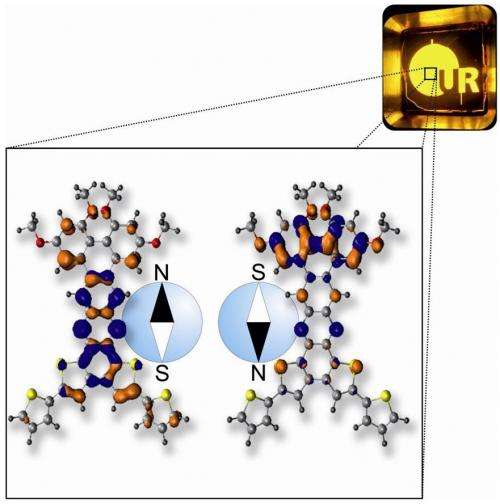Novel LEDs pave the way to cheaper displays

Researchers from the universities of Bonn and Regensburg have developed a novel type of organic light-emitting diode (OLED). These lights are suitable for the design of particularly energy-efficient cheap displays, which find applications in smart phones, tablet PCs or TVs. Applications in lighting such as in luminescent tiles are also conceivable. The scientists have now reported their findings in the journal Angewandte Chemie..
OLEDs are already used in the displays of smart phones or digital cameras today. They offer an especially bright image with high contrast, but come with a serious drawback: typically, only one quarter of the electrical energy invested in running the device is actually converted into light. This ratio can be raised by adding traces of noble metals such as platinum or iridium to the active material, but these elements are rare and very expensive. Making high-quality OLEDs is therefore a rather costly business.
This could change in the near future. The scientists from Bonn, Regensburg and the US have demonstrated a novel type of OLED, which shows potential for high conversion efficiencies without having to resort to noble metals. OLED displays could well get quite a bit cheaper soon.
OLEDs aren't really "organic"
OLEDs are called so because, ideally, they are made up of organic molecules, which consist solely of carbon and hydrogen. The operating principle of an OLED is rather simple: a thin film of the molecules is contacted by electrodes, which are connected to a battery so that an electrical current can flow. This current is made up of positive and negative charges. When the charges meet, they annihilate, destroying each other in a flash of light.
Since positive and negative charges attract each other, generating light from electricity should be a pretty efficient business. The problem lies in the intricate quantum-mechanical nature of charges, which also posses a magnetic moment – scientists call this the "spin". Charges with like spin repel each other, much as the north poles of two bar magnets do. This repulsion outweighs the attraction between positive and negative charges, so that different charges with like spin cannot generate light. Instead, they convert electrical energy into heat – a rather exotic and not overly useful way of electrical heating.
In conventional OLEDs this loss of energy occurs frequently: three quarters of all charges carry the same spin. Much like the needle of a compass, they point in the same direction but cannot touch each other, effectively lowering the yield of useful light. OLED manufacturers have come up with a clever trick to raise the yield: they twirl the compass needles around with an even stronger magnet, allowing the charges to generate light after all. To do this requires heavy metals such as platinum or iridium, which allow virtually all of the electrical energy to be converted into light. Strictly speaking, conventional materials in OLEDs are not organic compounds at all, but metal-organic substances. This distinction is more than semantic in nature, since noble metals are extremely expensive.
Useful spin flip flops
"We can also raise the efficiency using a different mechanism", Dr. John Lupton, Professor of Physics at the University of Regensburg, explains. "Charges can flip the orientation of their spins spontaneously – you just have to wait for long enough for this to occur." In conventional OLEDs, however, there is not enough time to do this since the electrical energy is not stored for long enough in the molecular architecture. Instead, the molecules give up and simply convert the energy to heat.
"It appears that, in our OLEDs, the molecules can store electrical energy for significantly longer than is conventionally assumed", notes chemists Professor Sigurd Höger of the University of Bonn. "Our molecules can therefore exploit the spontaneous jumps in spin orientation in order to generate light." The new compounds therefore hold potential to minimize electrical generation of heat in OLEDs without having to resort to any "metal-organic tricks", thereby converting the electrical energy very effectively into light.
More information: Metal-free OLED triplet emitters by side-stepping Kasha's rule; D. Chaudhuri, E. Sigmund, A. Meyer, L. Röck, P. Klemm, S. Lautenschlager, A. Schmid, S. R. Yost, T. Van Voorhis, S. Bange, S. Höger, J. M. Lupton; Angewandte Chemie (DOI: 10.1002/anie.201307601)
Journal information: Angewandte Chemie
Provided by University of Bonn





















